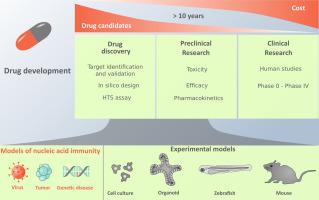Journal of Molecular Biology ( IF 4.7 ) Pub Date : 2020-08-26 , DOI: 10.1016/j.jmb.2020.08.016 Isabelle K Vila 1 , Maxence Fretaud 2 , Dimitrios Vlachakis 3 , Nadine Laguette 1 , Christelle Langevin 4

|
Unresolved inflammation fosters and supports a wide range of human pathologies. There is growing evidence for a role played by cytosolic nucleic acids in initiating and supporting pathological chronic inflammation. In particular, the cGAS-STING pathway has emerged as central to the mounting of nucleic acid-dependent type I interferon responses, leading to the identification of small-molecule modulators of STING that have raised clinical interest. However, several new challenges have emerged, representing potential obstacles to efficient clinical translation. Indeed, the current literature underscores that nucleic acid-induced inflammatory responses are subjected to several layers of regulation, further suggesting complex coordination at the cell-type, tissue or organism level. Untangling the underlying processes is paramount to the identification of specific therapeutic strategies targeting deleterious inflammation.
Herein, we present an overview of human pathologies presenting with deregulated interferon levels and with accumulation of cytosolic nucleic acids. We focus on the central role of the STING adaptor protein in these pathologies and discuss how in vivo models have forged our current understanding of nucleic acid immunity. We present our opinion on the advantages and limitations of zebrafish and mice models to highlight their complementarity for the study of inflammatory human pathologies and the development of therapeutics. Finally, we discuss high-throughput screening strategies that generate multi-parametric datasets that allow integrative analysis of heterogeneous information (imaging and omics approaches). These approaches are likely to structure the future of screening strategies for the treatment of human pathologies.
中文翻译:

用于核酸免疫研究的动物模型:新工具和新视角。
未解决的炎症会促进和支持多种人类病理。越来越多的证据表明胞质核酸在引发和支持病理性慢性炎症中发挥着作用。特别是,cGAS-STING 通路已成为核酸依赖性 I 型干扰素反应的核心,导致 STING 小分子调节剂的鉴定,引起了临床兴趣。然而,出现了一些新的挑战,成为高效临床转化的潜在障碍。事实上,当前的文献强调核酸诱导的炎症反应受到多层调节,进一步表明细胞类型、组织或生物体水平上的复杂协调。弄清楚潜在的过程对于确定针对有害炎症的特定治疗策略至关重要。
在此,我们概述了以干扰素水平失调和胞质核酸积累为特征的人类病理学。我们重点关注 STING 衔接蛋白在这些病理学中的核心作用,并讨论体内模型如何形成我们目前对核酸免疫的理解。我们提出了对斑马鱼和小鼠模型的优点和局限性的看法,以强调它们在人类炎症病理学研究和治疗方法开发方面的互补性。最后,我们讨论了生成多参数数据集的高通量筛选策略,这些数据集允许对异构信息(成像和组学方法)进行综合分析。这些方法可能会构建人类病理治疗筛查策略的未来。











































 京公网安备 11010802027423号
京公网安备 11010802027423号